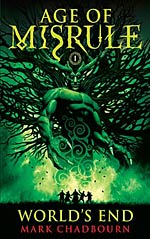
![]() Rhondak101
Rhondak101
3/2/2014
![]()
Before I began this book, I decided that I was not going to review it; however, about three-quarters of the way through I decided that I wanted to count this book for the 2014 RYO: LGBT challenge, which requires a review. Therefore, I've decided to review it briefly with LGBT issues in mind.
The world that is threatened in Mark Chadbourn's World's End is specifically the Age of Reason, our time, in which man has controlled the world, or in this case Great Britain. We never learn what is happening outside of Britain. Chadbourn mines Celtic mythology for much of his plot. Millennia before the Age of Reason, the area of Great Britain was inhabited by the Fomorii and the Tuatha dé Danann, who fought continuously over control of the land. However, the borders keeping these otherworldly creatures out of man's world are breaking. Monsters and magic are slipping through. There are dragons flying over Salisbury Plain, the Wild Hunt, led by the Erl-King, is roaming all over the English countryside, and creatures like the Loch Ness Monster are swimming around the Isle of Skye. Britain is about be invaded by the Fomorii, the worse of the two supernatural clans. The Fomorii seem immoral, while the Tuatha dé Danann seem more amoral. To stop the invasion that the Tuatha dé Danann knew would eventually come, these beings have been visiting five people in their dreams and preparing them to become heroes—world savers—when the time is right.
The novel opens with two of these five people, Jack and Ruth, witnessing a gruesome event, which begins their quest. Yes, this story follows a quest motif—very close to Joseph Campbell's monomyth. Along the way, Jack and Ruth add the other three, Ryan, Laura, and Shavi. Shavi is the subject of the rest of the review.
At first when Shavi comes out as bisexual to Ruth and Laura, I thought, how stereotypical. He had already been described as:
He was Asian, about 5 ft 10 ins, with shoulder-length black hair plastered to his head by the rain. As she closed on him, Ruth guessed he was probably of Indian blood; he had the most beautiful face she had seen on a man. His bone-structure was so finely cut, his eyes so wide and dark, his lips so full, that there was a hint of androgyny. (187)
Despite this description, Ruth reacts with "It's just, you don't seem gay!" when he first mentions a gay bar. To which, he explains he is bisexual: "I put no boundaries around my life" (221). It was only when the over-testosteroned Ryan calls Shavi a "shirtlifter" and Shavi responds: "I prefer to consider myself polymorphously perverse" that I decided that Chadbourn had thought through the character of Shavi. Shavi tells Ryan that polymorphously perverse"means I take my pleasure from wherever and whatever I please.... Why limit yourself to just one sex?" (342). Ryan later warns Shavi to stay away from him, but is then offended when Shavi assures him that Ryan is not his type. At first, I was disappointed that Ruth and Ryan's reactions were so stereotypical; then I realized that Chadbourn was making a point by having Shavi handle such stereotypical reactions. Moreover, these reactions do create a space in which Shavi says something smart about boundaries and limitations, which not only applies to his sexuality but to the book as a whole because all sorts of boundaries and liminal spaces have become permeable.
Of the five, Shavi is the most likeable character and performs heroic actions that none of the others could accomplish. He is portrayed very positively overall, as are the other two LGBT characters in the book, a gay couple who run a pub in the English countryside. World's End is the first book of a trilogy, and I'm very interested to see what Chadbourn does with the five characters and what other facets of Celtic mythology he can work into the next book.